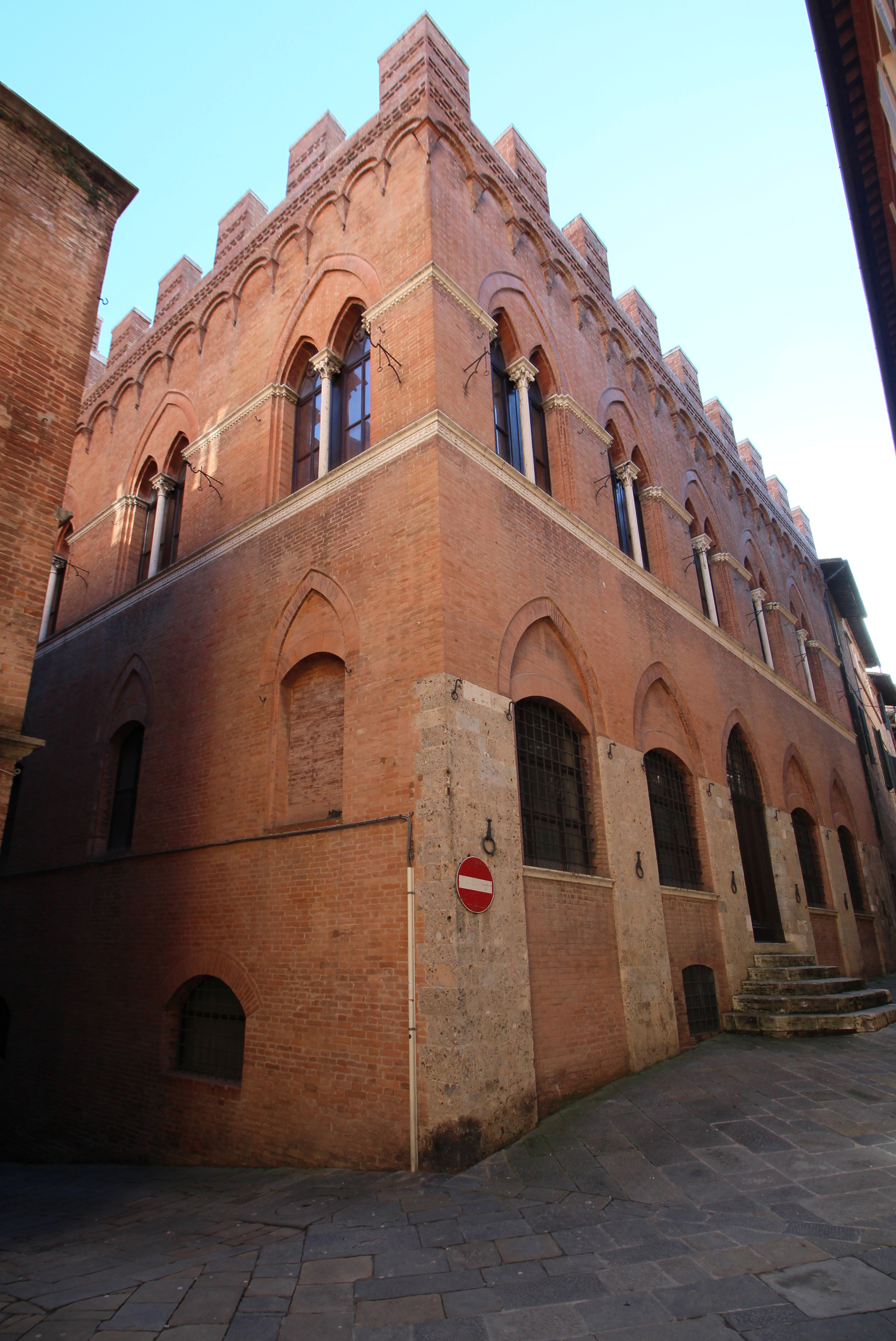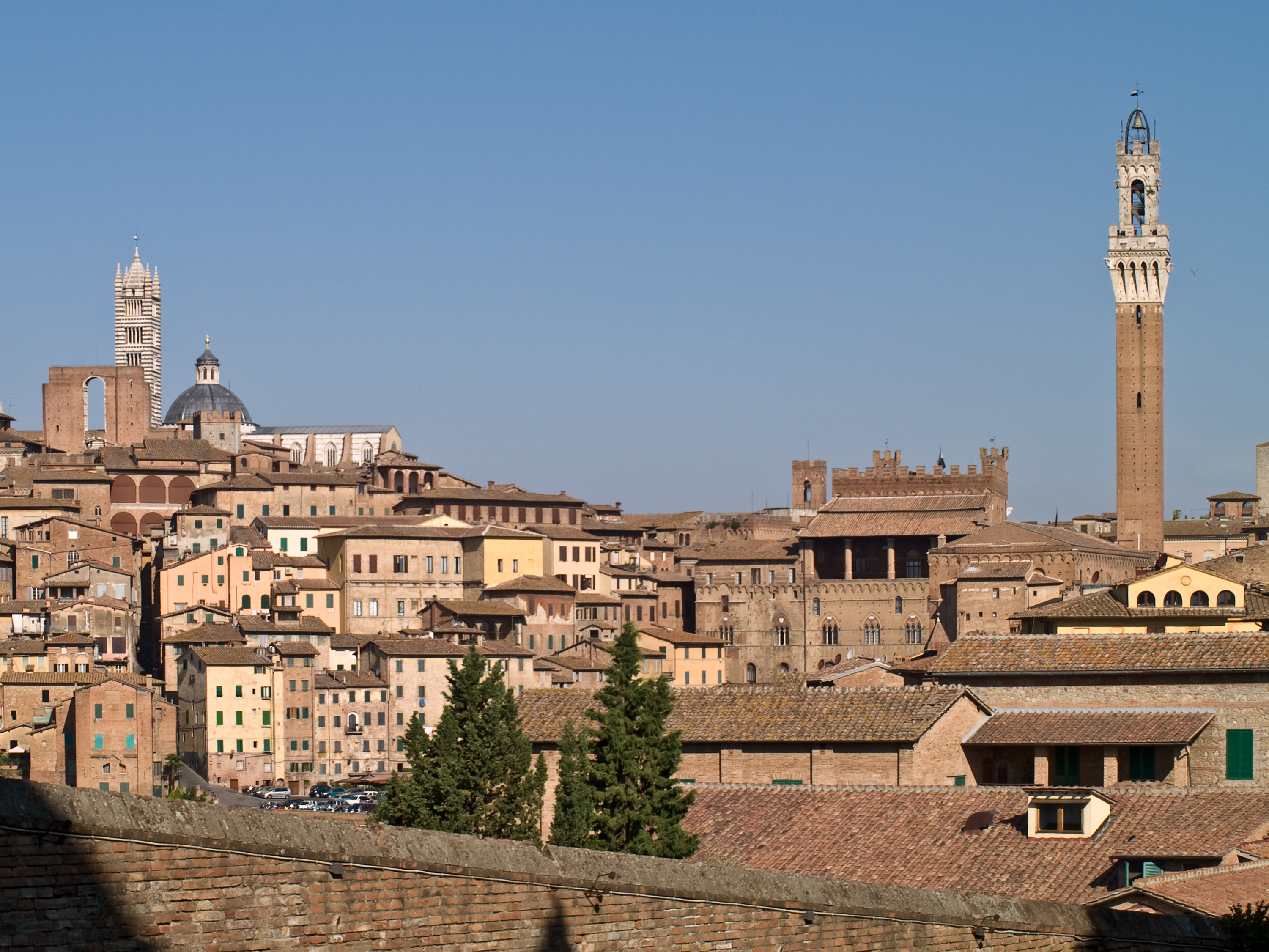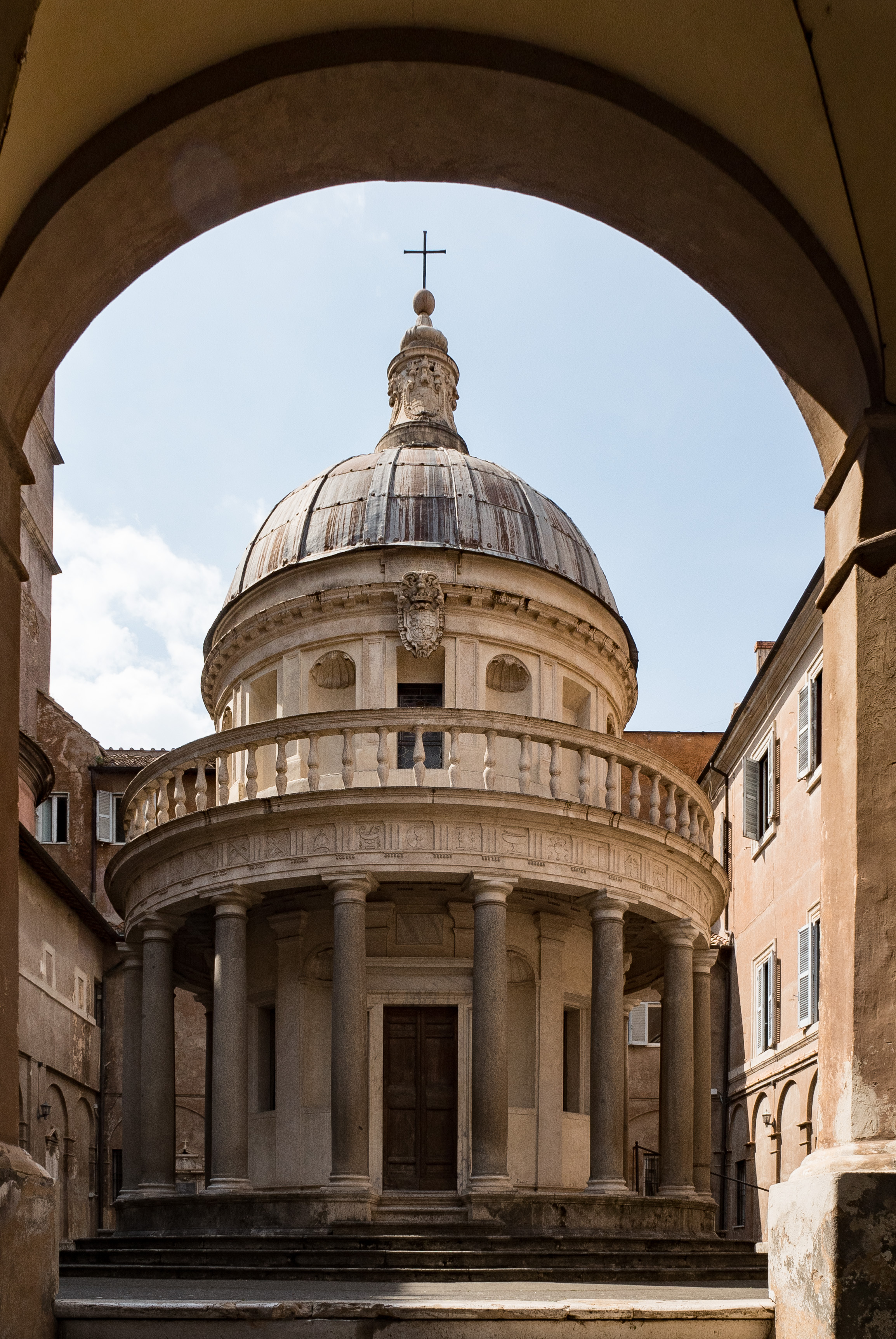|
Palazzo Marsili, Siena
The Palazzo Marsili is a Gothic style urban palace localized on Via di Città #124-132, in the Terzo di Città, in the city of Siena, region of Tuscany, Italy. adjacent on Via di Città to the shorter brick Palazzo Marsili-Libelli with plain rectangular second and third story windows. History The palace was erected at the site of a former palace in brick and stone with a Gothic style in the mid-15th century, when other palaces already began to show the influence of Florentine Renaissance. The architect was Luca di Bartolomeo Luponi. The palace was extensively restored in 1876 by Giuseppe Partini Giuseppe Partini (Siena, 1842–1895) was an Italian architect, mostly involved in reconstructions in his native Siena. ''Giuseppe Partini (1842-1895): architetto del purismo senese'' (1981) by Maria Cristina Buscioni. He was active with the sc .... The entrance on Via del Poggio has a marble external stairs extending into street. [...More Info...] [...Related Items...] OR: [Wikipedia] [Google] [Baidu] |
Gothic Architecture
Gothic architecture (or pointed architecture) is an architectural style that was prevalent in Europe from the late 12th to the 16th century, during the High and Late Middle Ages, surviving into the 17th and 18th centuries in some areas. It evolved from Romanesque architecture and was succeeded by Renaissance architecture. It originated in the Île-de-France and Picardy regions of northern France. The style at the time was sometimes known as ''opus Francigenum'' (lit. French work); the term ''Gothic'' was first applied contemptuously during the later Renaissance, by those ambitious to revive the architecture of classical antiquity. The defining design element of Gothic architecture is the pointed or ogival arch. The use of the pointed arch in turn led to the development of the pointed rib vault and flying buttresses, combined with elaborate tracery and stained glass windows. At the Abbey of Saint-Denis, near Paris, the choir was reconstructed between 1140 and 114 ... [...More Info...] [...Related Items...] OR: [Wikipedia] [Google] [Baidu] |
Siena
Siena ( , ; lat, Sena Iulia) is a city in Tuscany, Italy. It is the capital of the province of Siena. The city is historically linked to commercial and banking activities, having been a major banking center until the 13th and 14th centuries. Siena is also home to the oldest bank in the world, the Monte dei Paschi bank, which has been operating continuously since 1472. Several significant Renaissance painters worked and were born in Siena, among them Duccio, Ambrogio Lorenzetti, Simone Martini and Sassetta, and influenced the course of Italian and European art. The University of Siena, originally called ''Studium Senese'', was founded in 1240, making it one of the oldest universities in continuous operation in the world. Siena was one of the most important cities in medieval Europe, and its historic centre is a UNESCO World Heritage Site. From January until the end of September of 2021 it had about 217,000 arrivals, with the largest numbers of foreign visitors com ... [...More Info...] [...Related Items...] OR: [Wikipedia] [Google] [Baidu] |
Tuscany
it, Toscano (man) it, Toscana (woman) , population_note = , population_blank1_title = , population_blank1 = , demographics_type1 = Citizenship , demographics1_footnotes = , demographics1_title1 = Italian , demographics1_info1 = 90% , demographics1_title2 = , demographics1_info2 = , demographics1_title3 = , demographics1_info3 = , timezone1 = CET , utc_offset1 = +1 , timezone1_DST = CEST , utc_offset1_DST = +2 , postal_code_type = , postal_code = , area_code_type = ISO 3166 code , area_code = IT-52 , blank_name_sec1 = GDP (nominal) , blank_info_sec1 = €118 billion (2018) , blank1_name_sec1 = GDP per capita , blank1_info_sec1 = €31,500 (2018) , blank2_name_sec1 = HDI (2019) , blank2_info_sec1 = 0.907 • 6th of 21 , blank_name_sec2 = NUTS Region , blank_info_sec2 ... [...More Info...] [...Related Items...] OR: [Wikipedia] [Google] [Baidu] |
Palazzo Marsili-Libelli, Siena
The Palazzo Marsili Libelli is a Gothic style urban palace localized on Via di Città #136-142, in the Terzo di Città, in the city of Siena, region of Tuscany, Italy. The palace is adjacent to the taller Palazzo Marsili with a crenellated roofline and mullioned second and third story windows, and which stands at the corner of Via di Città and Via del Castoro. History The palace was made of brick in Gothic style in the mid-15th century, when other palaces were already beginning to show the influence of Florentine Renaissance as evidenced, for example, in Siena by the Palazzo Piccolomini. The origins of the Piccolomini family were linked this house as is evidenced by the coat of arms of Pope Pius II placed over the central entry portal, sculpted by Urbano da Cortona. The coat of arms has two cherubs lofting a papal tiara above a shield held by struggling angels. The shield has five crescents on a cross (argent on a cross azure 5 crescents or). The palace was owned after the Picco ... [...More Info...] [...Related Items...] OR: [Wikipedia] [Google] [Baidu] |
Renaissance Architecture
Renaissance architecture is the European architecture of the period between the early 15th and early 16th centuries in different regions, demonstrating a conscious revival and development of certain elements of ancient Greek and Roman thought and material culture. Stylistically, Renaissance architecture followed Gothic architecture and was succeeded by Baroque architecture. Developed first in Florence, with Filippo Brunelleschi as one of its innovators, the Renaissance style quickly spread to other Italian cities. The style was carried to Spain, France, Germany, England, Russia and other parts of Europe at different dates and with varying degrees of impact. Renaissance style places emphasis on symmetry, proportion, geometry and the regularity of parts, as demonstrated in the architecture of classical antiquity and in particular ancient Roman architecture, of which many examples remained. Orderly arrangements of columns, pilasters and lintels, as well as the use of semici ... [...More Info...] [...Related Items...] OR: [Wikipedia] [Google] [Baidu] |
Luca Di Bartolomeo Luponi
The last universal common ancestor (LUCA) is the most recent population from which all organisms now living on Earth share common descent—the most recent common ancestor of all current life on Earth. This includes all cellular organisms; the origins of viruses are unclear but they share the same genetic code. LUCA probably harboured a variety of viruses. The LUCA is not the first life on Earth, but rather the latest form ancestral to all existing life. While there is no specific fossil evidence of the LUCA, the detailed biochemical similarity of all current life confirms its existence. Its characteristics can be inferred from shared features of modern genomes. These genes describe a complex life form with many co-adapted features, including transcription and translation mechanisms to convert information from DNA to RNA to proteins. The LUCA probably lived in the high-temperature water of deep sea vents near ocean-floor magma flows around 4 billion years ago. Historical ... [...More Info...] [...Related Items...] OR: [Wikipedia] [Google] [Baidu] |
Giuseppe Partini
Giuseppe Partini ( Siena, 1842–1895) was an Italian architect, mostly involved in reconstructions in his native Siena. ''Giuseppe Partini (1842-1895): architetto del purismo senese'' (1981) by Maria Cristina Buscioni. He was active with the sculptor Tito Sarocchi in the reconstruction of the '' Fonte Gaia'' in Piazza del Campo Piazza del Campo is the main public space of the historic center of Siena, Tuscany, Italy and is regarded as one of Europe's greatest medieval squares. It is renowned worldwide for its beauty and architectural integrity. The Palazzo Pubblico and i ... in Siena Italy, replacement of its original panels with copies. He also helped in the reconstruction of the Palazzi Marsili and Tantucci in Siena. He was an architects involved with maintenance of the Duomo of Siena. He reconstructed the Palazzo di Giustizia in Chiavari. References 1842 births 1895 deaths 19th-century Italian architects Architects from Tuscany People from Siena {{it ... [...More Info...] [...Related Items...] OR: [Wikipedia] [Google] [Baidu] |
Palaces In Siena
A palace is a grand residence, especially a royal residence, or the home of a head of state or some other high-ranking dignitary, such as a bishop or archbishop. The word is derived from the Latin name palātium, for Palatine Hill in Rome which housed the Imperial residences. Most European languages have a version of the term (''palais'', ''palazzo'', ''palacio'', etc.), and many use it for a wider range of buildings than English. In many parts of Europe, the equivalent term is also applied to large private houses in cities, especially of the aristocracy; often the term for a large country house is different. Many historic palaces are now put to other uses such as parliaments, museums, hotels, or office buildings. The word is also sometimes used to describe a lavishly ornate building used for public entertainment or exhibitions such as a movie palace. A palace is distinguished from a castle while the latter clearly is fortified or has the style of a fortification, whereas a ... [...More Info...] [...Related Items...] OR: [Wikipedia] [Google] [Baidu] |
Houses Completed In The 15th Century
A house is a single-unit residential building. It may range in complexity from a rudimentary hut to a complex structure of wood, masonry, concrete or other material, outfitted with plumbing, electrical, and heating, ventilation, and air conditioning systems.Schoenauer, Norbert (2000). ''6,000 Years of Housing'' (rev. ed.) (New York: W.W. Norton & Company). Houses use a range of different roofing systems to keep precipitation such as rain from getting into the dwelling space. Houses may have doors or locks to secure the dwelling space and protect its inhabitants and contents from burglars or other trespassers. Most conventional modern houses in Western cultures will contain one or more bedrooms and bathrooms, a kitchen or cooking area, and a living room. A house may have a separate dining room, or the eating area may be integrated into another room. Some large houses in North America have a recreation room. In traditional agriculture-oriented societies, domestic animals such ... [...More Info...] [...Related Items...] OR: [Wikipedia] [Google] [Baidu] |

.jpg)





